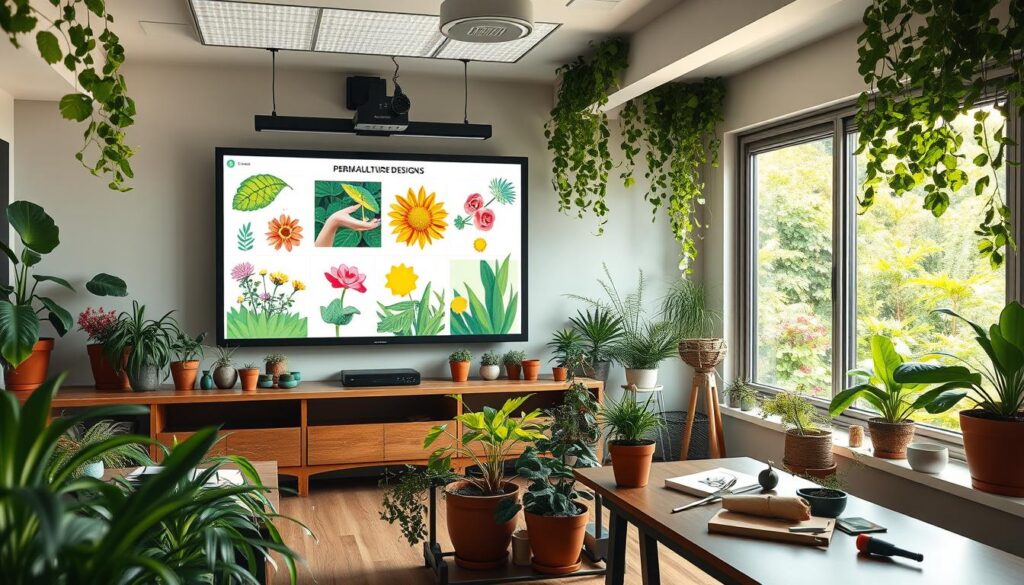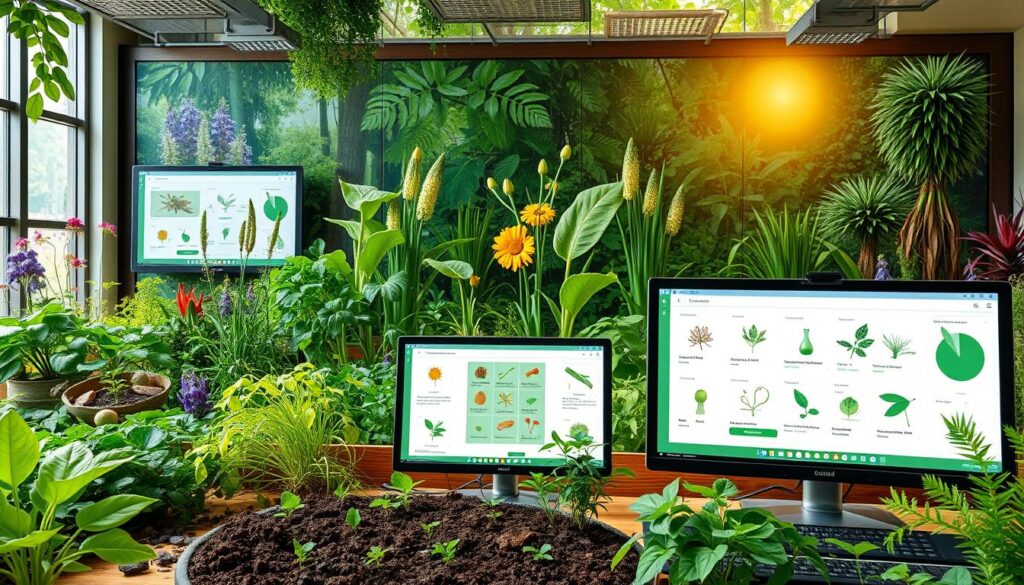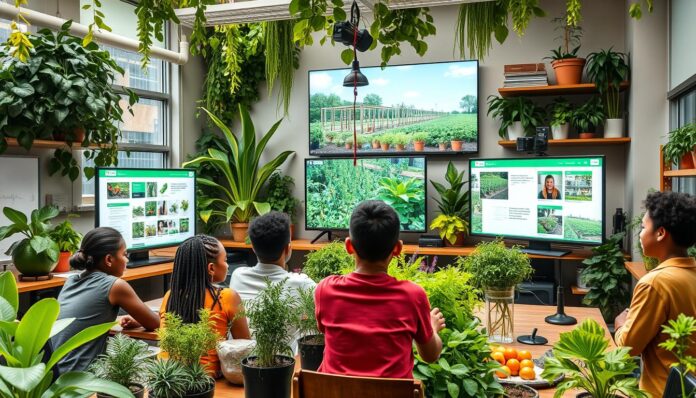Imagine if online permaculture teaching could spread sustainable practices worldwide. This could greatly help the environment and ensure humanity’s survival. Digital platforms now allow us to learn permaculture online and apply it locally. Experts like Heather Jo Flores believe permaculture tools are key to survival. Online education makes these tools more accessible, as shown on permaculture practice.
Key Takeaways
- Online permaculture teaching offers flexibility and accessibility, making it possible for people worldwide to learn sustainable practices.
- Permaculture courses online can complement traditional teaching methods, providing a broader reach and more diverse learning opportunities.
- With the help of digital tools, online permaculture teaching can be more engaging and effective, leading to a greater impact on the environment.
- Experts like Morag Gamble, with over 30 years of practical permaculture experience, are now offering online courses, such as the Permaculture Teacher Certificate, which includes 5 weekly modules and a 30-Day Money Back Guarantee.
- Online permaculture teaching can lead to certification, providing lifetime access to course materials and a global permaculture community for ongoing support and collaboration.
- Permaculture courses online are designed for diverse participants, including gardeners, educators, urban planners, and environmental advocates, indicating a broad appeal across various sectors.
- With over 100,000 learners already part of the global permaculture community, online permaculture teaching has the potential to make a significant impact on the environment and humanity’s survival.
Understanding Permaculture Principles
Permaculture is a way to design sustainable living systems. It works with nature, not against it. For those new to it, digital permaculture workshops and virtual classes offer a great start.
Definition and Origins of Permaculture
Bill Mollison and David Holmgren started permaculture in the 1970s. It combines “permanent” and “agriculture,” focusing on sustainable ecosystems.
Core Ethics of Permaculture
The core ethics are earth care, people care, and fair share. These guide permaculture design and implementation. Virtual permaculture classes can teach more about these ethics.
Key Design Principles of Permaculture
Permaculture’s key principles include observing nature and interacting with it. It also involves catching and storing energy and getting a yield. These can be learned through digital permaculture workshops and hands-on experience.
The Rise of Online Education in Permaculture
Online education has changed how we learn about permaculture. Web-based tutorials and internet courses are now more popular. This makes it easier for people to take permaculture courses, no matter where they are.
More people want flexible and easy-to-access learning. Internet courses let students learn about permaculture from anywhere. This is thanks to the growing demand for online learning.
Some benefits of online permaculture courses include:
- Flexibility: Students can learn at their own pace and on their own schedule.
- Accessibility: Online courses can reach a wider audience, including those in remote or underserved areas.
- Cost-effectiveness: Online courses can be more affordable than traditional in-person courses.
The global online education market is expected to grow fast. It’s set to grow at a CAGR of 23% by 2025. This shows a big demand for digital learning. More people are using web-based tutorials and internet courses to learn about sustainable living and environmental practices.

| Benefits of Online Permaculture Courses | Description |
|---|---|
| Increased accessibility | Online courses can reach a wider audience, including those in remote or underserved areas. |
| Flexibility | Students can learn at their own pace and on their own schedule. |
| Cost-effectiveness | Online courses can be more affordable than traditional in-person courses. |
Choosing the Right Online Permaculture Course
When looking for an online permaculture course, there are important things to think about. With more distance permaculture learning options, finding the right one is key. Consider if you’ll be working on a big rural property or a smaller urban one.
A good course should teach the basics of permaculture. It should also cover design principles. Some courses might focus on specific areas like social or spiritual aspects. Make sure the course matches your interests and goals.
Here are some key factors to consider when choosing an online permaculture course:
- Course content and structure
- Instructor expertise and experience
- Platform features and support
- Cost and time commitment
By looking at these factors, you can find a course that meets your needs. This will help you succeed in distance permaculture learning and remote permaculture training.
Many online platforms offer permaculture courses. They have everything from beginner modules to advanced certifications. These platforms are flexible, interactive, and connect you with others. They help you learn the skills needed for permaculture, whether you’re learning from afar or in a remote setting.
| Course Feature | Description |
|---|---|
| Course content | Covers core ethics and design principles of permaculture |
| Instructor expertise | Experienced instructors with expertise in permaculture |
| Platform features | Interactive learning tools, flexible scheduling, and community support |
Effective Teaching Methods in Permaculture
Online permaculture teaching needs new ways to keep students interested and learning. Permaculture courses online can use hands-on activities, group talks, and projects to help students learn and remember. The Midwest Permaculture website says it’s key to make teaching fun and interactive, even online.
Some great ways to teach permaculture include:
- Hands-on activities, like designing and starting permaculture projects
- Group talks and working together
- Projects that tackle real-world permaculture challenges
These methods work well for online courses, where students can’t meet in person. Online permaculture teaching can offer a full and engaging learning experience with these methods.
For instance, online courses can have virtual tours, interactive games, and group projects. They can also use digital tools like forums and discussion boards for students to talk and work together.
By using these teaching methods, online permaculture courses can give students a top-notch learning experience. This prepares them to use permaculture in real life. Whether it’s online or in person, the goal is to keep students engaged and actively learning.
| Teaching Method | Description |
|---|---|
| Hands-on activities | Designing and implementing permaculture projects |
| Group discussions | Collaborative learning approaches |
| Project-based learning | Working on real-world permaculture projects |
Utilizing Digital Tools for Permaculture Education
Permaculture education has changed a lot with digital tools. Now, we have virtual classes and workshops online. These make learning about permaculture easy and flexible.
These online platforms offer cool features like videos, quizzes, and forums. For example, you can watch video lectures and take quizzes. You can even go on virtual field trips to see permaculture in action.

- Increased accessibility: You can join from anywhere, making it easier to learn.
- Flexibility: You can learn at times that work for you, fitting it into your schedule.
- Cost-effective: Online workshops save money on travel and venue costs.
Digital tools help make learning fun and effective. They meet different learning styles. As more people want online classes, we need to keep improving these tools.
| Platform | Features | Benefits |
|---|---|---|
| Online Course Platforms | Video lectures, interactive quizzes, discussion forums | Flexible learning, increased accessibility, cost-effective |
| Virtual Event Software | Live streaming, virtual field trips, collaborative learning tools | Immersive learning experiences, increased engagement, reduced costs |
Developing a Curriculum for Online Courses
Creating a curriculum for online permaculture courses needs focus on practical skills and community. Heather Jo Flores says a good curriculum should have hands-on learning. This is great for web-based permaculture tutorials, where students can use interactive materials and work with others.
In internet permaculture education, the curriculum should meet different learning needs. It can do this by using various teaching methods, like video lectures, discussions, and activities. This way, students can really get permaculture and use it in real life.
Some important things to think about when making a curriculum include:
- Make sure the course has both theory and practice.
- Give chances for students to work together and share ideas.
- Use interactive and multimedia tools to make learning fun.
By keeping these tips in mind and using web-based permaculture tutorials and internet education, teachers can make great online courses. These courses will meet the needs of their students.
| Course Component | Description |
|---|---|
| Introduction to Permaculture | Covers the basics of permaculture principles and ethics |
| Practical Skills | Focuses on hands-on learning experiences and community engagement |
| Curriculum Development | Discusses best practices for creating effective online courses |
Engaging Students in Virtual Settings
Creating a community is key for learning permaculture online. Discussion forums and webinars help students connect with each other and teachers. For example, the Midwest Permaculture website has live review sessions on Zoom. This helps students feel part of a community.
Interactive activities like quizzes and role-playing make learning fun. They help students think critically and solve problems. Tools like Jigsaw puzzles can also make learning fun without spending a lot.
Here are some ways to keep students engaged online:
- Using storytelling to create relatable characters and situations
- Incorporating animated elements and humorous situations to facilitate a friendlier learning environment
- Utilizing game-based learning to encourage students to complete programs for better grades and rewards

By using these strategies, online permaculture learning can be more fun and effective. This leads to better results for students.
| Strategy | Description |
|---|---|
| Storytelling | Creating relatable characters and situations to impart knowledge |
| Game-based learning | Encouraging students to complete programs for better grades and rewards |
| Interactive activities | Utilizing quizzes, role-playing, and competitions to engage students |
Assessment and Feedback in Online Permaculture Teaching
Online permaculture teaching needs good ways to check if students get and use permaculture ideas. Permaculture courses online can use regular feedback, self-checks, and peer reviews to help students learn better.
Ways to see how students are doing include setting up places for feedback, like a Matters Arising board. Also, giving feedback during changes helps. Constructive feedback is key, and using the “Feedback Sandwich” method makes it easier for people to accept it.
Some important facts about feedback in online permaculture teaching are:
- More than 70% of people like getting feedback privately to avoid feeling anxious about public criticism.
- Using the “Feedback Sandwich” method makes people more open to feedback.
- Clear and short feedback is 30% more likely to stick with the person who gets it.
By using these methods in online permaculture teaching, teachers can make a supportive and effective learning space. 
| Technique | Description |
|---|---|
| Regular Feedback | Providing feedback at regular intervals to track student progress. |
| Self-Assessment | Encouraging students to evaluate their own learning and understanding. |
| Peer Review | Allowing students to review and provide feedback on each other’s work. |
Incorporating Sustainable Practices into Online Teaching
As more people want virtual permaculture classes and digital workshops, it’s key to teach online sustainably. We can do this by choosing eco-friendly tools and teaching students to live sustainably. Heather Jo Flores says using green digital tools helps lessen online learning’s environmental footprint.
To lower online learning’s environmental impact, we can use energy-saving devices and cut down on paper. We can also encourage students to use public transport or carpool to online classes. They can also use devices that save energy during workshops.
Online teachers can also teach students about living sustainably by adding topics like sustainable design and soil science to their lessons. This way, students learn about sustainable practices and how to use them every day.
- Less harm to the environment
- More engaged students
- Better learning results
By teaching sustainably online, teachers can make learning more fun and effective. They also help students learn to live sustainably and reduce the environmental impact of online learning.
| Benefits | Strategies |
|---|---|
| Reduced environmental impact | Using energy-efficient devices, reducing paper usage |
| Increased student engagement | Incorporating sustainable practices into the curriculum |
| Improved student outcomes | Promoting sustainable behavior in students |
Case Studies of Successful Online Permaculture Programs
Online permaculture education is getting more popular. Many places offer web-based permaculture tutorials. The Midwest Permaculture website is a great example. It offers a detailed permaculture design certificate course.
Thanks to the internet, people worldwide can learn permaculture. They can take courses and get advice from experts. Some top online permaculture programs include:
- The Permaculture Life YouTube channel, with over 125,000 subscribers
- The Permaculture Education Institute, which offers a range of online courses and has won several prestigious awards
- The International Permaculture Festival of Ideas, which features contributors from around the world
These programs show how online education can reach many people. They teach sustainable practices. By using the internet, these places help spread permaculture knowledge and inspire change.
As more people want online permaculture education, we’ll see new and better programs. They will help us learn and grow.
| Program | Description |
|---|---|
| Permaculture Life YouTube channel | Offers practical, hands-on permaculture skills through videos |
| Permaculture Education Institute | Provides online courses and has won several prestigious awards |
| International Permaculture Festival of Ideas | Features contributors from around the world and promotes permaculture knowledge |
Building Your Brand as an Online Permaculture Instructor
Having a strong online presence is key for permaculture instructors. It lets them reach more people and promote their courses well. With more distance learning, instructors can teach students worldwide. To succeed, focus on making great content, connecting with your audience, and being seen as a permaculture expert.
Being an authority means offering training that meets different student needs. For example, Morag Gamble’s Share Permaculture marketing course teaches a lot about permaculture. It also helps students market their projects well. With over 145 lessons and 72 hours of content, it’s a great way to become a permaculture pro.
Here are some tips for building a strong brand as an online permaculture instructor:
- Make a professional website and social media accounts.
- Find what makes you different from others.
- Interact with your audience through webinars and forums.
- Work with other permaculture experts.
By using these strategies and focusing on quality learning, you can become a respected permaculture teacher. As more people look for online permaculture training, your brand can grow. This means more chances to make a difference and attract dedicated students.
| Course | Duration | Content |
|---|---|---|
| Share Permaculture marketing course | 20 live classes | Over 72 hours |
Future Trends in Online Permaculture Education
The demand for online permaculture teaching is on the rise. The Midwest Permaculture website notes that technology will be key in shaping this field. Now, students can find a variety of online courses and learn from experts.
New trends include virtual and augmented reality, artificial intelligence, and blockchain. These tools can make learning more fun and interactive. For example, virtual reality lets students dive into permaculture designs in a hands-on way.
Online permaculture courses are getting more popular. It’s important to keep up with the latest in this area. Schools can offer a deeper understanding of permaculture by adding online courses to their programs.
The future of online permaculture education is bright. With technology advancing, we’ll see even more innovations. Whether you’re new to permaculture or experienced, online courses can help you grow.
| Technology | Application in Permaculture Education |
|---|---|
| Virtual Reality | Immersive experiences, exploring permaculture designs and systems |
| Artificial Intelligence | Personalized learning, adaptive assessments, and intelligent tutoring systems |
| Blockchain | Secure and transparent certification, verification of permaculture credentials |
Conclusion: The Future of Permaculture Learning
The rise of online education has changed how we learn permaculture. Now, students all over the world can access virtual classes and workshops. These digital tools make learning permaculture easy and fun.
Keeping this momentum going is up to us. We need to keep learning and growing in permaculture. By doing this, we help the next generation become leaders in sustainability. They will learn by doing and understand how nature works together.

